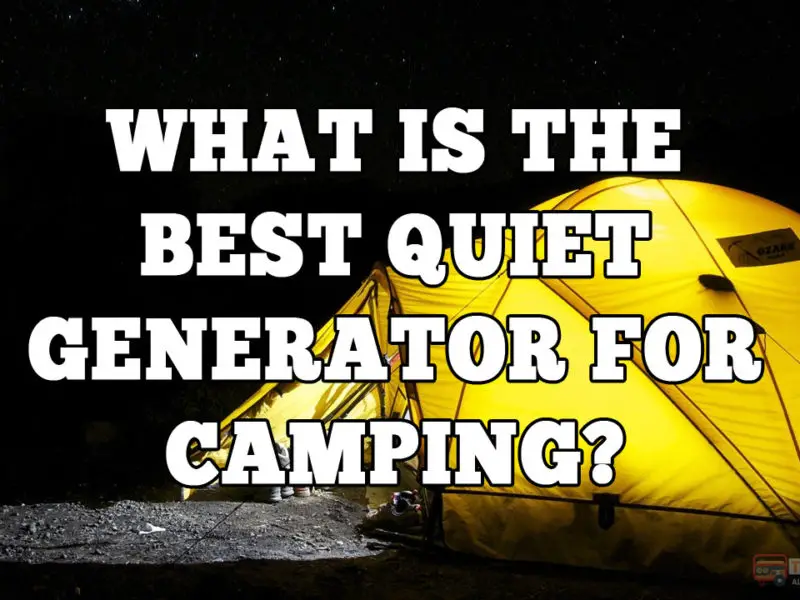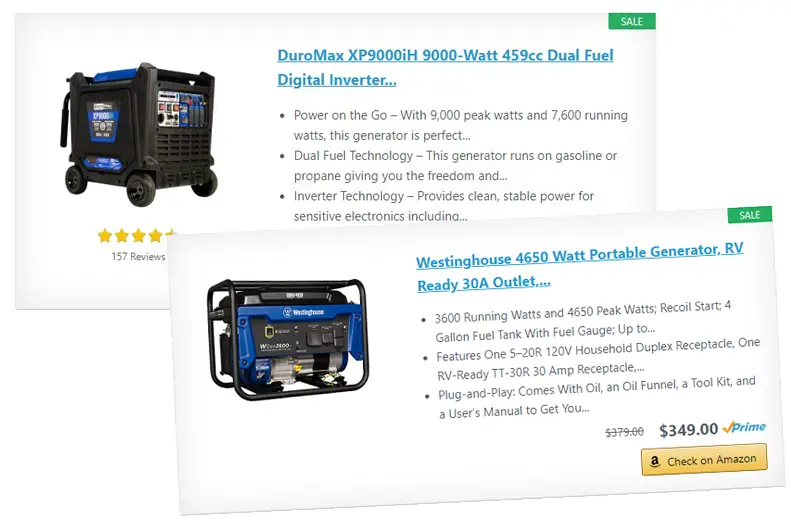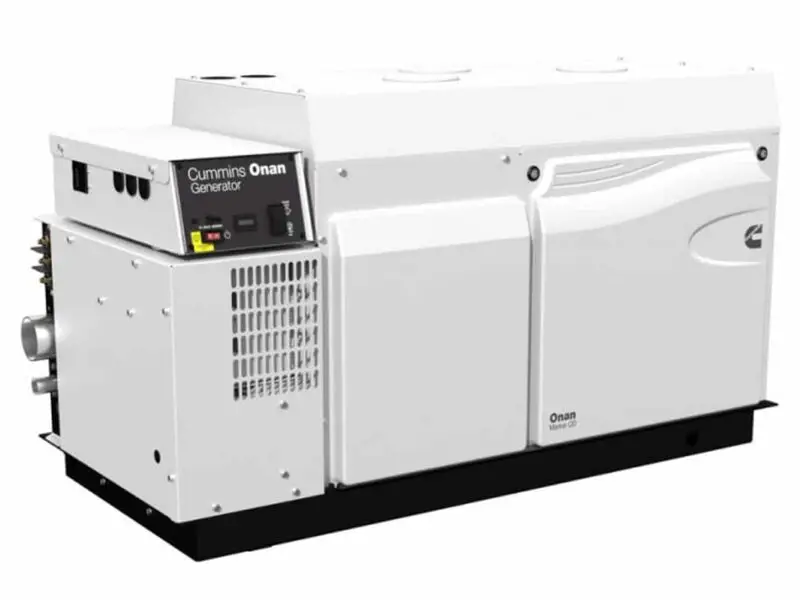Portable generators have become increasingly popular in the recent past as homeowners and business premises take greater caution against potential power losses. We have compiled a list of some of the best portable generator products on the market during 2024.
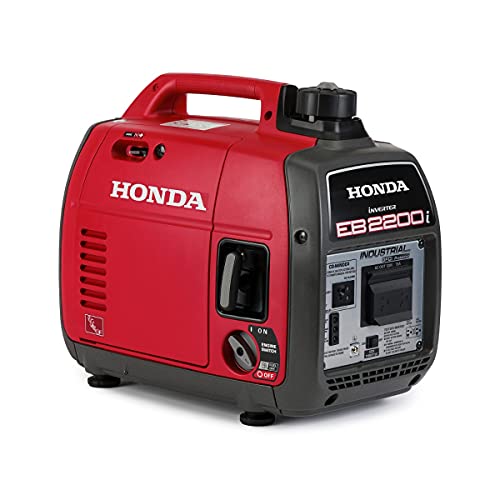









A portable generator can be the last line of defense when the power goes out or when your area experiences a grid interruption. Otherwise, you may have to spend a night in the darkness and watch as your groceries go bad inside the refrigerator.
The best part is that you can bring the portable generator pretty much anywhere. So, whether you need to power your laptop outside under the tree as you work on a business project or install temporary lighting at the business premise for an event, the portable generator will come in handy. You can even bring it on your boat to power your electronics.
For these above reasons, it helps to purchase the best portable generator you can afford. This guide offers tips, pointers, and recommendations to help you buy the best portable generator within your budget.
Product Reviews; The Top 8 Portable Generators
The following are eight of the best options to consider when shopping for a portable generator for your home or any other application.
1. Honda EU2200i 2200-Watt Companion Super Quiet Inverter Generator
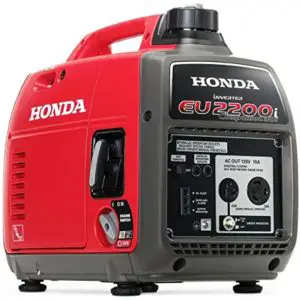
Let’s kick with the 120cc, 2200-watt inverter generator from Honda. It’s a small generator that weighs just under 47lbs. The physical size is also compact enough to bring on a boat or even when camping. However, at 2200 watts, it is more than powerful enough to run everyday appliances. The inverter function allows it to charge phones and laptops directly.
There’s a lot to love about the model EU2200i Honda. For one, it’s an electric injection generator that burns with few emissions. Additionally, it features a built-in eco-throttle feature that ensures fuel conservation, allowing the small one-gallon tank to run for up to eight hours. It also features an automatic decompressor that makes startups a breeze.
Pros
- Fuel injection technology for fewer emissions
- Long run times at minimized noise
- Lightweight design with carrying handle
- Built-in eco-throttle system
Cons
- Emits strong gas smell when running
- Small fuel tank capacity
This generator has an electric starter system, so you don’t have to worry about pulling a starter cord. It also boasts a larger oil filler opening and a bigger oil drain gutter for easier oil changes. Safety features on the EU2200i include a fuel shutoff valve. It produces a mere 57 decibels at peak operation, making it one of the quietest units around.
- MORE POWER. SAME LEGENDARY QUALITY. - The EU2200i Companion delivers 10% more power than the...
- CO-MINDER - Advanced Carbon Monoxide Detection System. CO-MINDER continuously monitors carbon...
- HONDA MY GENERATOR APP + BLUETOOTH CAPABILITY - Honda's exclusive My Generator smartphone app...
2. Generac GP3000i Super Quiet Inverter Generator
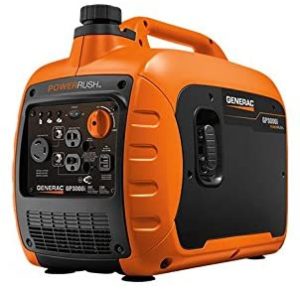
If you’ve shopped for a generator before, you’ll be well aware that Generac is one of the biggest names in the department. They make powerful generators that remain reliable throughout the year. Their generators are also notably quiet, and their prices are fair.
In fact, the main reason we’ve selected the model GP3000i is the price vis-a-vis value. The generator is powered by PowerRush Technology, an innovative Generac technology that delivers 50% more starting capacity than comparable models. This means you can do more with less. It’s also an inverter generator that performs quietly.
Pros
- Power Rush energy-saving technology
- Quiet inverter operation
- Multiple power outlets
- Two USB ports
- 2-year warranty
Cons
- Small fuel tank
- Short run time
Above all, the spark ignition (SI) generator is highly portable. It’s very light and compact, making it easy to bring on your travels. At just 59.5lbs, it’s also lightweight enough to carry on one hand. An ergonomic handle makes carrying a breeze. It has multiple outlets, including two USB ports and an AC plug.
- PowerRUSH Technology - Delivers over 50% more starting capacity-allowing you to do more with...
3. DuroStar DS7000Q Portable Generator
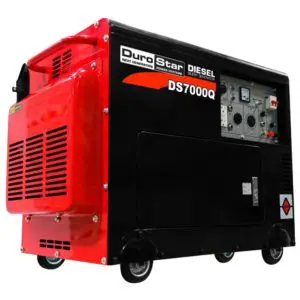
In the buying guide section, you’ll find out that diesel generators are some of the most powerful as diesel produces more BTU/watts per unit volume. Therefore, it’s not surprising that the first diesel generator on this list produces 5,500 watts in regular operation and up to 6,000 watts at peak operation. Few are better if you’re looking for a powerful yet compact portable generator.
The four-stroke cylinder, direct-injection model DS7000Q from DuroStar has two 120-volt, 20-amp outlets with a ground fault interrupter. Both outlets are 3-prong, meaning they work for standard household appliances without any modification. In addition, it also has two 30-amp twist outlets for bigger applications, such as on the farm or worksite.
Pros
- Cons tons of power, up to 6,000 watts
- Electric start and remote control
- Wheel kit for mobility
- 12 hour run time
- 1-year warranty
Cons
- Too bulky at 300lbs
- It’s expensive
Other key features of the generator include a large (3.83-gallon) tank that runs for 12 hours on half load and a noise-reducing vibration-isolating mounting between the engine feet and base frame. Although it’s bulky at 300lbs, the wheel kit makes it easy to transport.
No products found.
4. Champion Power Equipment Dual Fuel Portable Inverter Generator
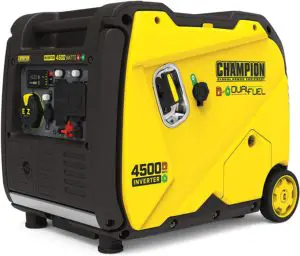
Some of the most attractive generators today are multi-fuel units that can use either of two pre-selected fuels. If you’re excited by this versatility, one of the best dual-fuel units is the 3400-watt RV-ready portable generator from Champion, which can operate on propane or gasoline.
It generates 3400 watts per hour and holds 0.6 quarts of oil. Additionally, it possesses a low-oil shutoff feature to protect the tank from damage when it runs out of fuel. We also love that it comes with a three-position ignition switch built-in and an in-built quick touch panel for convenient user control. At a59dB from 23 feet away, it’s also quiet enough for regular home use.
Pros
- Dual-fuel engine for versatility
- Low-oil shutoff sensor
- Quick touch control panel
- 3-year limited manufacturer warranty
Cons
- It’s a tad expensive
The tank lasts 7.5 hours on regular operation, which is just below average. However, you’ll be glad to know that the unit generates clean power with very few emissions. A 120V, 30A RV outlet, and 120V, 20A outlet with less than 3% total harmonic distortion (THD) makes it essentially a plug-and-go system. Additionally, it has a 12V DC outlet.
- DUAL FUEL: Operate your 4500-watt portable generator right out of the box on either gasoline or...
- ELECTRIC START: Battery included, plus Quick Touch Panel allows you to access all your controls...
- QUIET OPERATION: 61 dBA is perfect for RVs, tailgating, your next project or backup power for...
5. Westinghouse WG3600v Portable 4-Gallon Generator
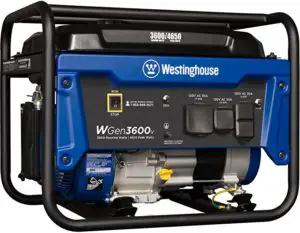
You’ll quickly find out about portable generators that often manufacturers cut down the tank size to deliver a more compact unit for greater mobility. But what if you’re more concerned about raw power than size? What if you’re prepared to bear the increased weight as long as you can have more watts?
That’s where units such as the Westinghouse WG3600V come in handy. This gasoline generator is a massive unit weighing 99 pounds, only about 30lbs less than the average human. It’s also fairly large at 23 x 17 x 18 inches. However, it’s one of the most potent portable gasoline generators, capable of delivering up to 4650 watts at peak operation.
Pros
- Cast iron sleeve for long-term durability
- Large 4-gallon fuel tank
- Automatic low oil shutdown
- EPA and CARB compliant
- 3-year limited warranty
Cons
- Manual recoil start
- Fairly bulky
There’s more. The generator has a 4-gallon tank that can run for 18 hours straight at regular speed. A fuel gauge is included to help you monitor the level of the fuel. Its outputs include a 5-20R 120V household duplex receptacle and an L5-30% 30A receptacle.
- 3600 Running Watts and 4650 Peak Watts; Recoil Start; 4 Gallon Fuel Tank With Fuel Gauge; Up to...
- Features One 5–20R 120V Household Duplex Receptacle, One RV-Ready TT-30R 30 Amp Receptacle,...
- Plug-and-Play: Comes With Oil, an Oil Funnel, a Tool Kit, and a User’s Manual to Get You...
6. Pulsar G12KBN Duty Portable Dual Fuel Generator
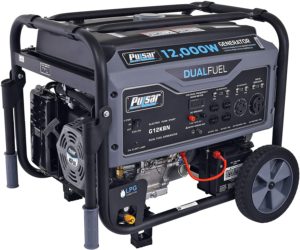
However, if you want a truly powerful portable generator, perhaps for backup purposes, there aren’t many better options than the model G12GBK from Pulsar. The dual-fuel generator, which runs on either propane or gasoline, can generate up to 10,800 watts on gasoline and a record 12,000 watts when on propane. Twelve thousand watts is more than enough to keep home essentials, including lighting, the TV, fridge, and freezer, running during a power outage.
The incredible power is thanks to a 457cc single-cylinder, 4-stroke, air-cooled OHV engine. Better still, it uses electric button ignition. So, no cord pulling. It has a massive fuel, too, at 8.0 gallons. The tank can run for 12 straight hours when full.
Pros
- Incredible power, up to 12,000 watts
- Multiple power outlets
- Low-fuel safety shutoff
- Automatic voltage regulation
- 1-year limited warranty
Cons
- Slightly bulky
- It’s pricey
It has enough output ports to keep you going. For one, it has 4x 12V 20A AC outlets, more than most portable generators. Additionally, it has a 120V/240V 30Z twist-lock outlet and a 120V/240V 50A outlet. You’ll also find a valuable 12V DC outlet. Although it’s a little bulky, the ergonomic handles and 10-inch wheels ensure easy mobility.
- 12, 000 peak watts/ 9, 500 Rated watts (gasoline) & 10, 800 peak watts/ 8, 550 Rated watts...
- Dual fuel capability allows you to choose between gasoline & LPG fuel sources; great for...
- The 457cc, single cylinder, 4-stroke, air cooled, OHV engine with electric start is protected...
7. Briggs & Stratton 40325 Natural Gas Generator
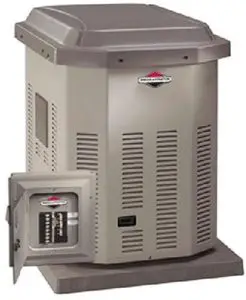
You’re likely wondering whether there are any natural gas options on the list. Yes, we’ve got one, the Briggs & Stratton model 40325. We chose it because of its massive power and the fact it comes with the initial setup to make the installation process simple. It also comes with a fuel conversion kit if you run out of natural gas and wish to switch to propane. However, remember that fuel conversion installation is strictly for the experts.
Anyway, the model 40325 offers 10,000 watts, making it the perfect backup power solution for small to medium-sized homes. You can place it as close as 20 inches to your home, provided your local codes allow it. At that distance, it still generates only about 67dBs from inside the house.
Pros
- Powerful at up to 10,000 watts
- Installation kit included
- Supports automatic load transfer
- Power management mechanism
- 3-year limited manufacturer warranty
Cons
- Fairly expensive
- It’s a massive, bulky unit
It supports Automatic Transfer Switch (ATS) integration for automatic load transfer to the generator in a power outage. The only downside is that you must purchase the switch separately. The automotive galvanized steel housing with powder coating provides protection against rust, chipping, and abrasion.
Unfortunately it seems that this specific generator has been discontinued and you can only buy a used one.
8. Winco HPS12000HE360 Tri-Fuel Portable Generator
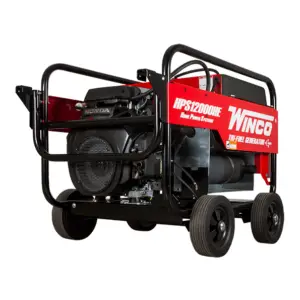
Let’s round off with a portable tri-fuel generator that can run on three different fuels – the model HPS12000He 360 from Winco. This generator runs on a Honda GX engine, making it reliable and efficient. It’s also very powerful, capable of delivering up to 12,000 watts at peak performance when running on gas. Besides gas, it can also operate on natural gas and propane.
It has a 15-gallon tank that lasts 14.5 hours on gasoline. However, if you choose propane, you need 2.2 gallons per hour. The natural gas setting consumes 200cc per hour on full load. And, you don’t have to worry about pulling a start cord as it comes with an electric start button.
Pros
- Powerful at up to 12,000 watts
- Uses up to three different fuels
- Electric button start
- CARB and EPA compliant
- Has multiple safety features
Cons
- It’s a bulky unit
- It comes at a high price
We love that the unit arrives with a flat free wheel kit and folding handle for easy mobility. More importantly, it arrives with the needed tri-fuel carburetor and a gas regulator to prevent accidents. A Honda oil alert warning system is also built into the generator so you can quickly know when you’re running low on fuel.
Currently unavailable.
We don’t know when or if this item will be back in stock.
Buying Guide
Have you ever spent a night without power? Unfortunately, for most people, the answer is yes. This is especially true for homes without a backup power system. Relying exclusively on the power grid means you’re left in darkness whenever there’s an outage.
Or it could be worse. For instance, imagine the power going out when you’re in the middle of an office task or working on a business project, perhaps an email campaign that you intend to schedule for a morning blast! Or maybe you just restocked your grocery.
Without adequate backup, you’d be at the mercy of your utility provider, the weather, or both. Otherwise, you might be counting massive losses.
Arming yourself with a portable power generator is one of the best ways to protect your home and business in case of a grid outage.
What’s a Portable Generator?
Electric power generators are machines that convert mechanical power into electric power for use in an external circuit. Common mechanical energy sources are wind turbines, gas turbines, water turbines, hand cranks, and internal combustion engines.
A portable generator is mobile enough to be moved from one location to another without undue strain. Portability is naturally dependent on weight and physical dimensions. A portable generator is lightweight enough to be carried around by hand or pushed on wheels and small enough in physical dimensions to move with ease.
How Do Portable Generators Work?
Portable generators come in many types and styles. The working mechanisms depend on the type of generator.
That said, though, most portable generators in domestic and light commercial applications are internal combustion engines. Of course, solar generators and hydrogen generators are more popular now than ever before. Wind-powered generators are also very common today. However, internal combustion engine generators are, by far, still the most common.
Why? Because internal combustion engine generators;
- Are extremely reliable
- Are not weather-dependent
- Generate tons of power
- Are cheaper than options such as hydrogen
The internal combustion engine helps convert the chemical energy in the selected fuel into mechanical energy that helps turn a shaft. The shaft, in turn, rotates the rotor component of the generator’s alternator, creating an electromagnetic field through induction.
Fundamental physics tells us you can harness electron flow in an electromagnetic field to generate electric current (electricity).
So, How Does the Internal Combustion Engine Power Generator Work?
It depends on the type of fuel. We’ll discuss the different fuels in greater detail shortly. However, portable generators generally operate on diesel, gas/petrol, natural gas, or propane.
Some models can use multiple gases. For instance, bi-fuel generators can operate on two different fuels, one at a time or together. Meanwhile, tri-fuel models run on three different gases. Such generators are known as multi-fuel units.
Anyway, diesel generators have a different type of internal combustion engine than the other fossil fuels. Most fossil fuels use spark ignition (SI) engines, while diesel engines use compression ignition (CI) engines.
How Spark Ignition (SI) Engines Work
Spark ignition engines, which power gasoline, natural gas, and propane generators, use a spark plug to ignite fossil fuel. The process goes as follows;
- The engine mixes air + fuel in the carburetor.
- The air + fuel mixture is injected into the combustion chamber via the inlet valve.
- A piston within the chamber compresses the mixture during the first upward stroke.
- The compression significantly raises the temperature of the fuel + air mixture.
- The spark plug ignites the now very hot air + fuel mixture.
- The combustion process causes massive expansion, creating pressure and forcing the piston down.
- The piston, which attaches to the engine’s crankshaft via a metal rod, causes the shaft to rotate.
- The piston moves upward (the second time in one cycle) when the pressure falls, opening the exhaust valve and letting out exhaust gases.
- The process resumes from step #2, with the injection of fuel + air into the combustion chamber.
The process repeats, again and again, thus maintaining the shaft rotation. The faster it rotates, the faster the shaft rotates.
How Compression Ignition (CI) Engines Work
Compression ignition engines are slightly different. For one, they don’t require a carburetor as the fuel mixes with air inside the combustion chamber. Instead, they have an injector at the top of the combustion chamber that sprays fuel into the chamber. Secondly, CI engines rely exclusively on air compression to ignite the fuel. The process is as follows;
- The piston is released from the Top Dead Center (TDC), i.e., the topmost part of the combustion chamber.
- As it moves down due to its weight, it creates a vacuum that opens the inlet valve and draws air (only) into the combustion chamber.
- The inlet valve closes at the bottom of the stroke.
- The piston moves upward, compressing the air to very high temperatures.
- At the top of the upward stroke, the fuel injector sprays diesel into the chamber at high pressure.
- Instant combustion occurs.
- The pressure/expansion resulting from the combustion pushes the piston down in the second downstroke.
- The downstroke generates enough power to turn the engine shaft
- The shaft turns the alternator rotor.
How the Alternator Generates Electricity
The alternator, also popular as the generator head, is the part of the generator that creates electricity. It converts the mechanical energy from the rotating engine shaft into an electromagnetic field and harnesses the resulting electron flow. The alternator has two main parts, the rotor/armature, and stator.
- The stator: Is a stationary set of wire coils over iron ore. It creates a magnetic field that helps generate the desired electromagnetic field.
- The rotor: Is the rotating component. It connects directly to the rotating engine shaft (as stated earlier) and rotates in tandem with the shaft. The rotation around the stator creates an electromagnetic field that induces electron flow, as the law of induction states. The resulting current is known as alternating current.
Power Output
The current from the alternator then passes through the voltage regulator, where it’s stabilized with the help of rectifiers. Then the stable current is made available to the external circuit via the control panel. From here, you can tap the current to power your appliances and devices.
Pros and Cons of Portable Generators
Why are portable generators so popular? And, what are some of the challenges associated with a portable generator?
Advantages
- Portability: Portable generators are mobile enough to be deployed in various applications around and even outside the home.
- Versatility: The portability of such generators means they can serve in a wide range of scenarios. You can even bring the home generator to power your small shop during an outage.
- Backup power: Some portable generators are large enough to provide backup power for the entire home.
- Affordable: Although some are pricey, a standard portable generator costs no more than a few hundred dollars. The starting price is only $200.
Challenges
- Rising power costs: The main downside of portable generators and fossil fuel generators, in general, is the rising fuel costs. It’s a major concern.
Types of Portable Generators
The most straightforward way to categorize portable generators is by fuel type. As such, we can have the following categories;
Gas Generators
Portable gas generators operate exclusively on gasoline/petrol. They burn gasoline through spark ignition to produce torque that drives the engine shaft and, ultimately, the alternator. The alternator then generates electricity from the resulting electric field.
Pros
- Gas is widely available
- It is affordable
- It burns with ease
- Gas engines are very light/portable
Cons
- Low energy potential
- Short storage life span
Diesel Generators
Portable diesel generators are almost similar to gas generators except that they use compression ignition engines that rely on air compression to ignite the fuel. Once the fuel ignites, the rest of the process is similar.
Pros
- It’s one of the most potent fuels
- Diesel engines are hardy and durable
- The fuel has a long shelf life
- Diesel is the most affordable fossil fuel
Cons
- Diesel engines are bulky and complex/less portable
- Repairs, though fewer, are more expensive
Natural Gas Generators
Portable natural gas generators are similar to gas engines. They use spark ignition to combust a mixture of fuel and air. The main difference is that natural gas lines connect directly to the generator while, with gas, you must refill the tank when it runs empty. Additionally, very few natural gas generators are portable.
Pros
- Exceptional convenience (no refills)
- Very reliable (rarely runs out)
- Natural gas burns very cleanly
- It’s more affordable than propane
Cons
- Inherent safety issues
- Gas lines may not be available in your location
Propane Generators
Portable propane generators are also spark-plug ignition units. However, propane is mixed with water (held in the tank) to form ammonia rather than mix the fuel with air. Compressing the ammonia causes it to heat up, resulting in combustion at TDC.
Pros
- Propane is a potent power source
- It’s widely available
- Propane cans are highly portable
- Leaks are easy to detect
Cons
- It is more expensive than natural gas
- Frequent refills can be tiring
Multi-Fuel Generators
Finally, some portable generators support more than one fuel. For instance, bi-fuel and dual-fuel systems can use two different fuels, such as natural gas and propane. Meanwhile, tri-fuel units can operate on up to three different fuel types, such as natural gas, propane, and gasoline.
Pros
- Extremely versatile/flexible
- Low risk of running out of fuel
- Often highly portable
- Can support a wide range of applications
Cons
- Very delicate, fuel confusion can cause high risk
- They’re typically pricier than single-fuel models
Considerations When Shopping for a Portable Generator
If you decide to invest in a portable generator, whether for backup power or as the primary power source for your RV, you need to find the best one for the job. Here’s what to consider;
1. Size (in watts)
A generator too small or too big for the application isn’t ideal. Overly small generators may fail to provide enough power to cover all your appliances and devices. Meanwhile, an oversize unit may be unnecessarily costly to run.
So, begin by assessing your power needs. Then, list all the intended applications alongside the power demands (running power + starting wattage). The total will tell you your power requirements.
FAQ: What Size Generator Do I Need to Run my Whole House?
2. Fuel type
We’ve discussed the main fuel types. Now, you need to select the best option to fulfill your needs. We recommend diesel or natural gas if you’re shopping for a backup power generator to serve the whole house. These two are better suited to large applications.
However, if you’re shopping for a smaller unit, perhaps for fishing, then a propane or gasoline generator would be more than sufficient. These two are also generally cheaper.
3. Run time
Besides size and fuel type, you should also check the run time (typically given in hours) to determine whether the generator would serve you well. The tun time tells you how long the generator can run on a full tank and, therefore, is directly dependent on the tank size.
Ideally, you want a unit that can run for at least 10 hours on a full tank. However, it also depends on the application. For larger applications, such as a backup power generator, a longer runtime may be more beneficial. On the other hand, even seven hours is a long enough run time for boating generators.
4. Noise level
Generators are inherently noisy. Most of them are rated 70 decibels or higher. However, this doesn’t mean you can’t find quieter models. You can even find sufficiently powerful portable generators rated below 55 decibels.
Here, we recommend making the decision based on your priorities. If your top priority is raw power, as is when shopping for a backup generator, then you can do with a bit of noise. So, about 65-70 decibels is acceptable. However, for smaller applications that require quieter environments, such as a home office, feel free to compromise on power for a quieter model, say 50-55 decibels.
FAQ: What is the Best Quiet Generator for Camping?
5. Output and controls
Different generators have different outputs and controls. For instance, a standard portable generator has at least two AC output ports and one DC output. A few USB ports and extra converters and switches would also be handy.
When it comes to controls, consider whether you need to pull a start cord or dial an electric start button to start the unit. Additionally, check for voltage selectors, a visible fuel gauge, an odometer, number of household plugs, and transfer switch signal.
6. Safety features
The best generators are safe enough for use at home. To this end, you want a generator with sufficient safety insurance. Top of the list should be spark arrestors to stop the generator from emitting flammable particles and built-in surge protectors to protect the generator and your appliances in case of a voltage spike.
Beyond the two, consider units with built-in circuit protection (to protect you from electrocution) and low-fuel shutdown to protect the generator from damage when it runs out of fuel.
7. Convenience and other features
Other features to look out for when shopping for a portable generator include the physical size and weight, accessories (such as wheels and fuel converters), ease of setup, and whether it has a circuit protector.
Newly released portable generators
The list below shows the most recently introduced portable generators you might be interested in. We will review them in the coming months.
- 【Empowerment Through Eco-Friendly Solar...
- 【Exceptional Durability and Safety】-...
- 【4 Ways to Recharging】- You can charge it...
- 【Portable & Foldable】: This 45W solar...
- 【Multifunctional output】: The solar panel...
- 【High Efficiency】: This foldable solar...
- 【High Quality Material】This handcranked...
- 【Performance】The DC generator features a...
- 【No Rust, No Obvious Scratch】The...
Wrap Up
Now you know some of the best portable generators on the market and how to pick the right one. However, we just want to warn you never to use the wrong fuel in your generator. First, always get your fuel from accredited suppliers. Secondly, make sure it’s fresh fuel. And lastly, use only the fuel type(s) the manufacturer recommends. Otherwise, you may damage the engine.
For multi-fuel generators, ensure professional fuel conversion kit installation and follow manufacturer instructions when switching fuels.





